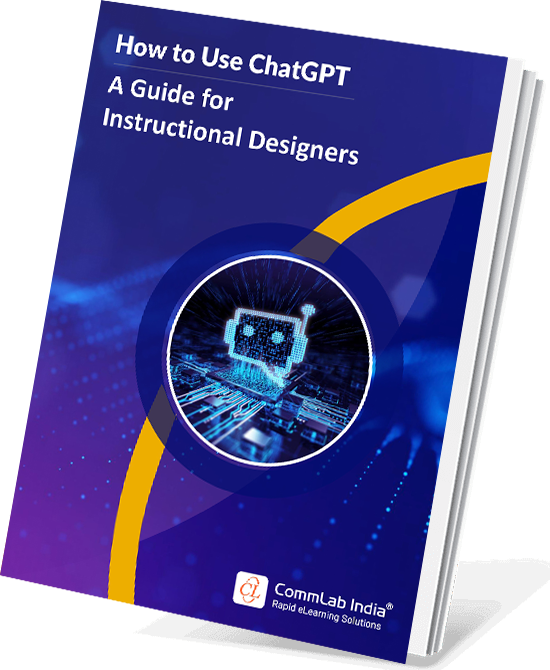Top 5 Digital Learning Formats for Successful Corporate Training

The modern corporate world is a whirlwind of activity. Employees juggle demanding targets, manage client relationships, and constantly strive to deliver exceptional service. In this fast-paced environment, fitting into traditional training programs can feel like a herculean task. This is where digital learning comes to the rescue. It incorporates a variety of formats that offer a transformative approach to corporate training. Digital learning formats allow learners to ditch the monotony of traditional training methods and make the most of engaging, interactive learning experiences. Moreover, innovative digital learning formats cater to the busy schedules of the modern-day workforce, enabling employees to learn effectively without wasting their precious time.
→ Download Now: Instructional Design — Unleashing the Power of ChatGPT
Table of Contents
- What Are the Challenges of Traditional Classroom Training?
- How Digital Learning Ensures Effective Learning in Corporate Training?
- What Are the 5 Digital Learning Formats for Effective Corporate Training?
What Are the Challenges of Traditional Classroom Training?
One-size-fits-all approach: In traditional classroom training method, information is delivered in a uniform way. However, learners have different paces, learning styles, interests, and prior knowledge. This can result in ineffective, low-impact training outcomes.
Limited engagement: Unidirectional lectures and instructor-centered activities often struggle to keep the learners actively involved in the learning process, thus leading to inattentiveness during the training session and difficulty in retaining information.
Focus on memorization: Traditional training often has its base in bulky manuals and long lectures which set the ground for rote memorization instead of fostering critical thinking and the ability to apply knowledge in real-world situations.
Lack of personalization: It can be difficult for instructors to cater to individual learning needs of employees in a large classroom setting.
Outdated content: With the market landscape changing faster than ever, keeping training materials up-to-date with the latest information and industry trends can be challenging.

How to Use ChatGPT — A Guide for Instructional Designers
Create Immersive Learning Experiences by leveraging ChatGPT
- Frame Learning Objectives
- Generate Scenarios
- Design Assessments
- And More!
How Digital Learning Ensures Effective Learning in Corporate Training?
Increases Accessibility: Digital learning eliminates time and location barriers in corporate training, thereby enabling employees to learn at their own pace, on their schedule, and from any device.
Measurable Results: Digital learning allows training managers to track learner progress and performance data. They can use the data insights to assess the effectiveness of training programs and identify areas for improvement.
Engaging and Interactive: By offering scope to incorporate multimedia elements like videos, audio, eLearning interactivities, simulations, game-based elements, etc., digital learning makes the learning process more engaging and interactive. This results in better attention, understanding, and knowledge retention.
Cost-Effective: In contrast to conventional classroom training, digital learning eliminates the need for travel, venue rentals, and instructor costs, thus reducing the training expense significantly.
Personalized Learning: With the help of digital learning platforms, instructors can tailor learning paths based on individual learning needs and learning styles. Personalized learning helps employees to focus on areas where they need the most improvement, resulting in improved efficiency and performance at work.
What Are the 5 Digital Learning Formats for Effective Corporate Training?
What Are the Top 5 Digital Learning Formats for Effective Corporate Training?
Here's the list:
- Gamification
- Video Content
- Microlearning
- Simulation-Based Learning
- Virtual Instructor-led Training (VILT)
With eLearning courses, you don’t need to stick with just text-heavy modules. Using powerful eLearning authoring tools and advanced instructional design strategies, you can create exciting, immersive eLearning courses that engage your learners without putting too much strain on their already overworked minds. Let’s look at some of them:
1. Gamification
Gamification incorporates game mechanics like points, badges, leaderboards, and challenges into non-game contexts, like corporate training. It makes the learning process engaging and exciting as it fosters healthy competition among the learners and motivates them to complete training modules and improve their skills. However, it's important to design gamification thoughtfully. Incorporating game-based elements in your training courses meaninglessly can backfire. So make sure the game mechanics align with the learning objectives of your corporate training and help employees acquire valuable skills.
Watch this video to learn how you can integrate digital learning and gamification for desirable, impactful results.
2. Video Content
Videos are the perfect digital learning format to captivate the attention of your learners and convey information in an impactful way. Videos use a combination of attractive visuals, immersive animations, and meaningful voiceovers that make it easier for learners to understand and remember complex concepts. Since videos stimulate the visual and hearing senses of learners, the rate of information transfer is considerably higher compared to text-heavy, monotonous training courses.

How to Use ChatGPT — A Guide for Instructional Designers
Create Immersive Learning Experiences by leveraging ChatGPT
- Frame Learning Objectives
- Generate Scenarios
- Design Assessments
- And More!
3. Microlearning
Hectic work schedule of employees leaves little time for learning. That’s why instead of a full-length eLearning course you should consider using microlearning modules. This digital learning format focuses on delivering information in the form of bite-sized learning nuggets. Microlearning modules aim to deliver comprehensive information on a single learning objective. Given the short duration of these courses and easy accessibility, they are an ideal choice in today’s learning ecosphere. Listed below are the 10 best examples of microlearning formats that you can use in your training courses to maximize the impact and engagement.
.png?width=1920&height=1080&name=10%20Best%20Examples%20of%20Microlearning%20Assets%20(2).png)
4. Simulation-Based Learning
Nothing captures the attention of your learners more than giving them hands-on experience of the subject. Simulations make that possible by giving your learners a consequence-free environment to practice a tool or software application. For e.g. you can give hands-on training on your SAP software without any live production impact. By emulating a scenario, learners are not left in any kind of doubt about what they will face in the real world. This digital learning format is a great solution to foster and maintain learners’ attention as they are not just sitting and observing, but rather are actively involved in the learning process.
5. Virtual Instructor-led Training
VILT stands for Virtual Instructor-led Training. It's essentially a live online training session where an instructor delivers the material and interacts with participants remotely.
Unlike pre-recorded lectures, VILT sessions take place in real-time using video conferencing platforms. This allows instructors to deliver presentations, share multimedia content, and most importantly, facilitate live discussions and answer questions. Here’s an infographic highlighting the benefits of VILT for learners.

Furthermore, VILT eliminates the need for travel and venue rentals, making it a cost-effective way to train a large, geographically dispersed workforce.
In The End!
By adopting digital learning formats, you can ditch the mundane and embrace a world of engaging possibilities. With a vast array of options available, you can tailor your training programs to meet your specific needs and create truly memorable learning experiences for your employees. So, embrace the digital revolution and watch your corporate training take flight! When it comes to digital revolution, AI is at the forefront. So stay ahead of your competition by leveraging AI for your corporate training initiatives. Check out our handy guide on how to use ChatGPT for designing effective, learner-centric training courses.
Editor's note: This post was originally published on April 10, 2018 and has been updated for comprehensiveness.





![Want to Upskill and Reskill Your Employees? Try Rapid eLearning [Video]](https://blog.commlabindia.com/hubfs/Imported_Blog_Media/rapid-elearning-upskill-reskill-employees-video.jpg)